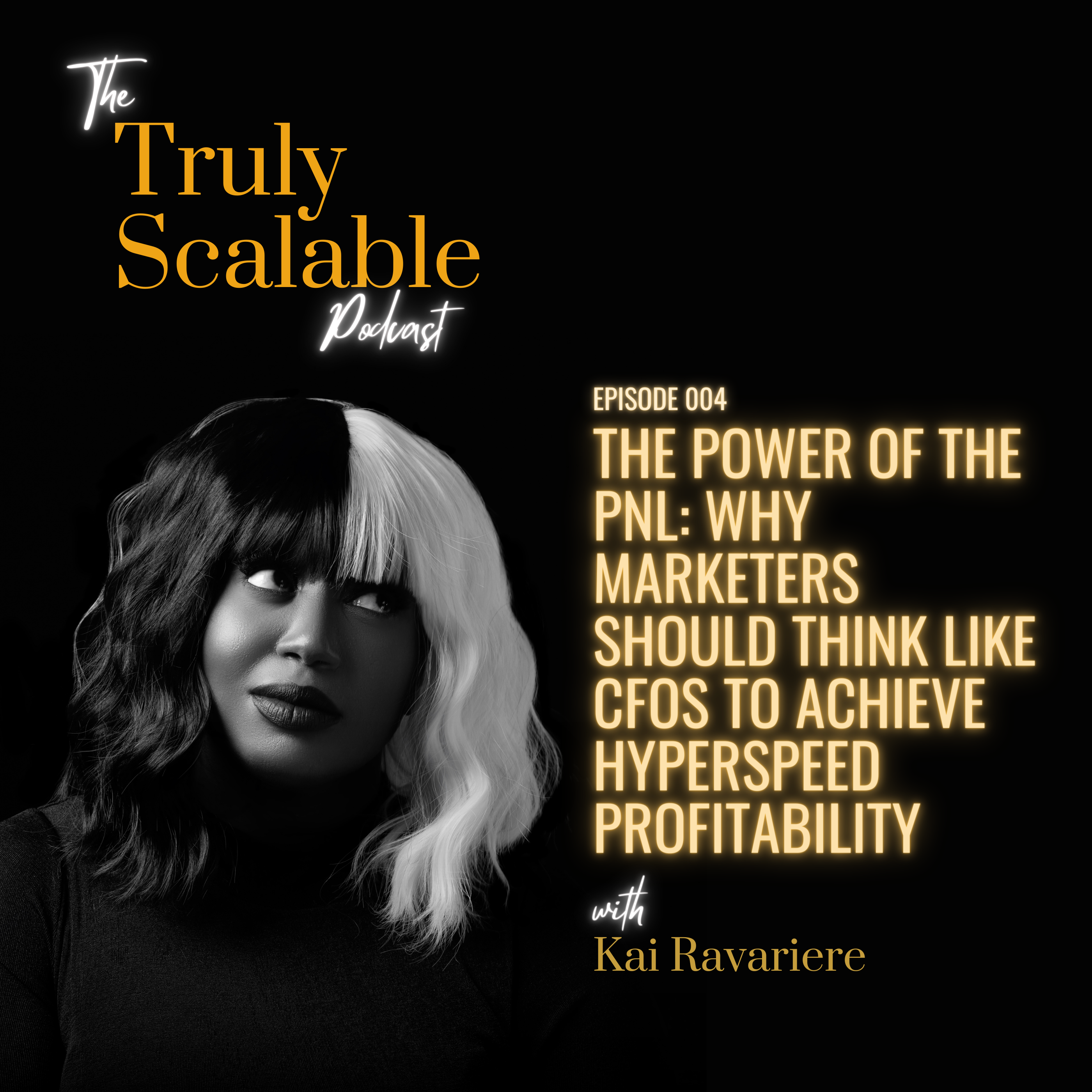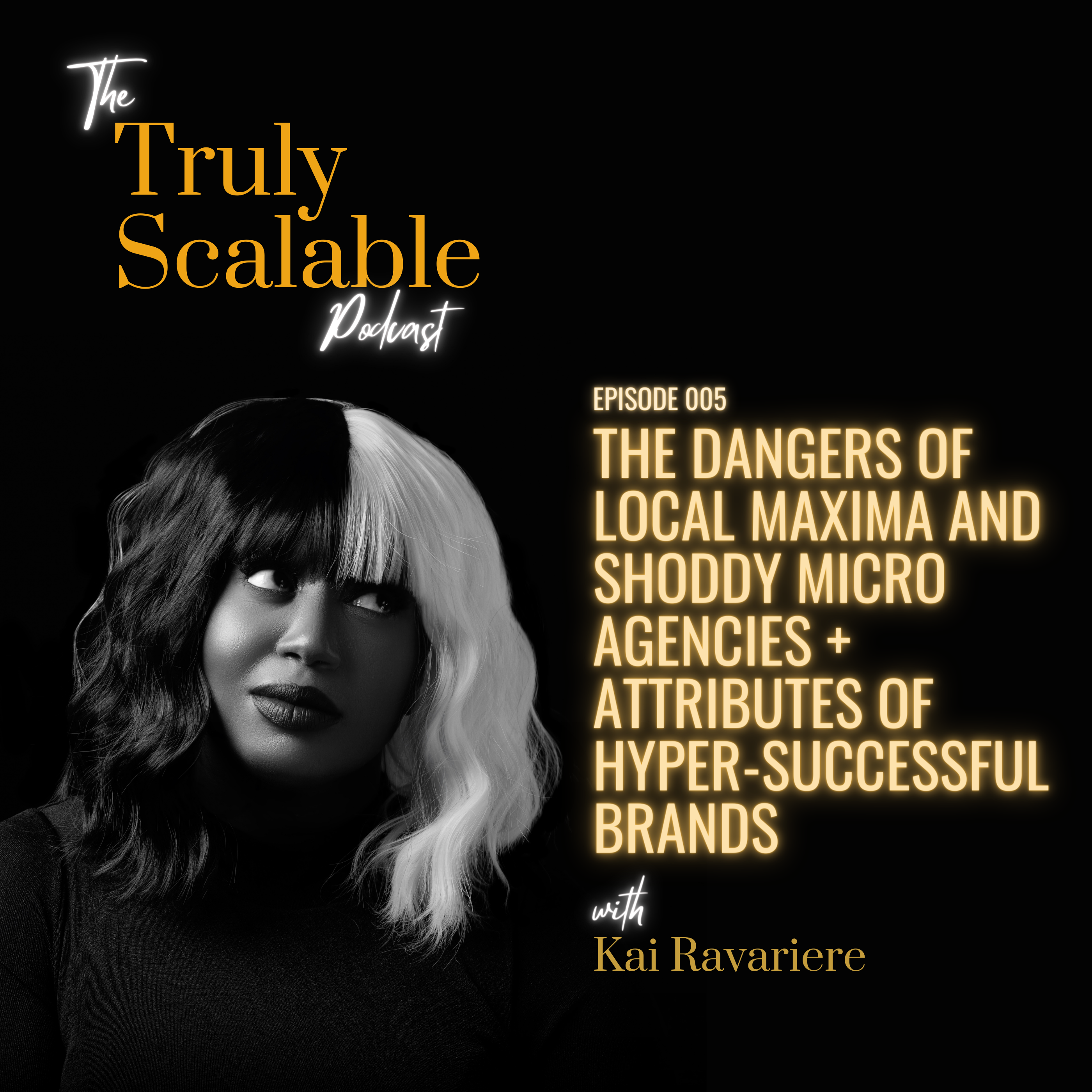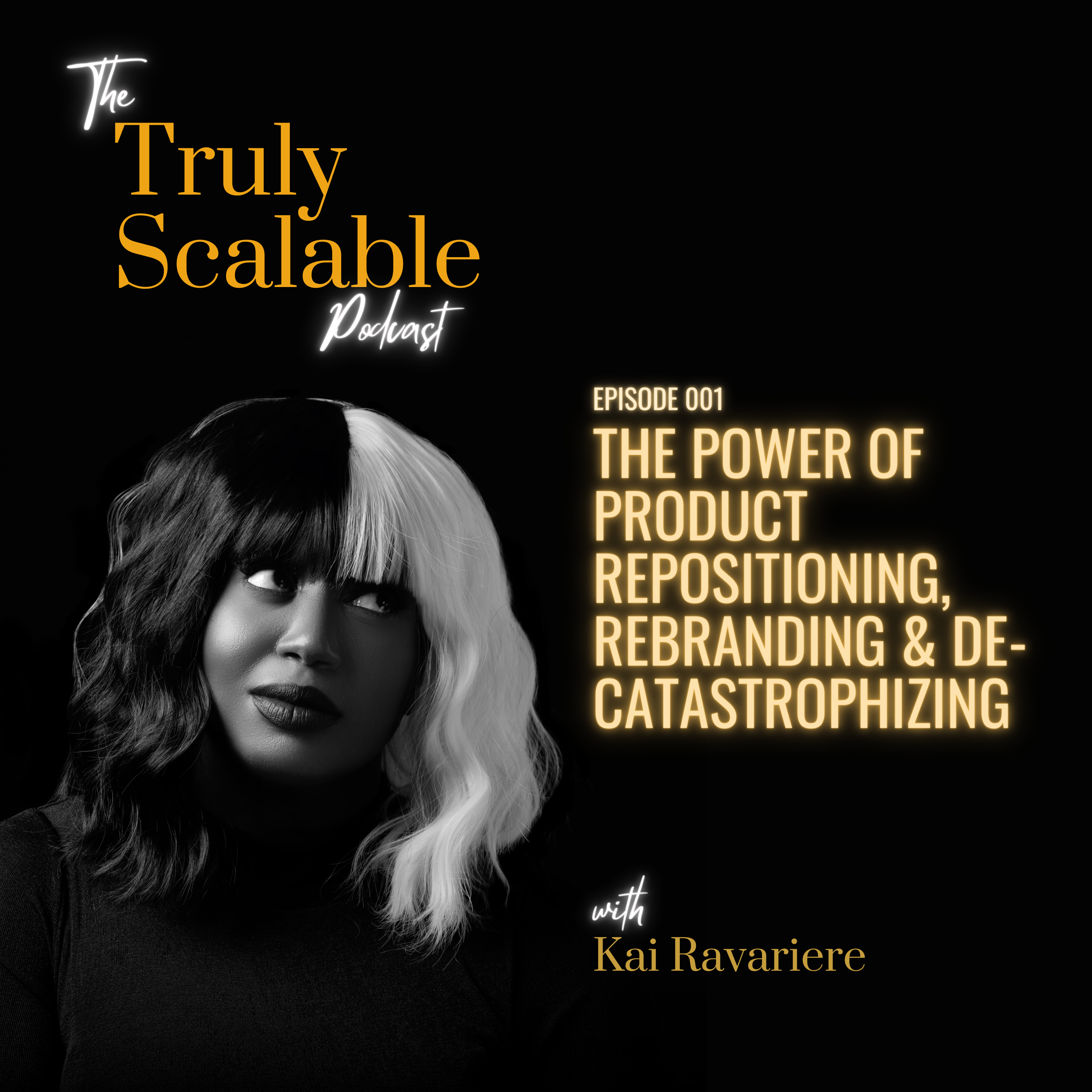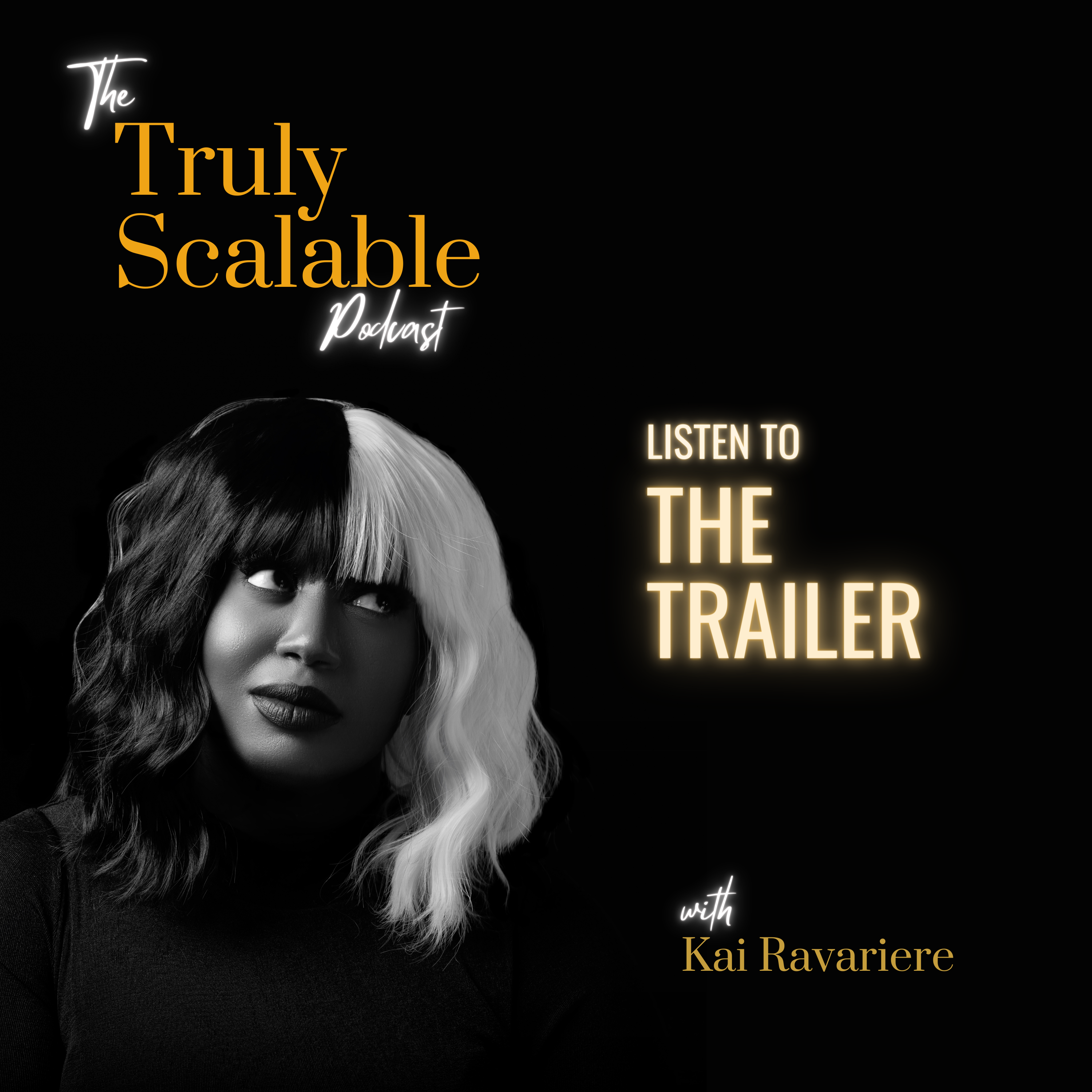Episode Transcript
[00:00:01] This is the Truly Scalable podcast, the inner mind of a paid media executive empowering ecommerce brands to optimize and strengthen the backbones of their brands, companies, teams and themselves to ensure a fast, highly profitable scaling, growth and success. However you define it, victories, failures, scandals, cautionary tales lessons on growth scaling frameworks revelations in marketing and advertising... join me as I break down frameworks, dispel myths and shift paradigms for e commerce brand founders and CMOs to strengthen the makeup of their businesses and layer smart strategies for maximum profitability at scale. I'm Kai Ravariere and I'm here to help you become Truly Scalable.
[00:00:51] Most of the time, the modus operandi of an organization, whether they’ve raised funding or not, is predominantly incremental, top-line revenue growth. Rather, when it comes to making strides in their business, they’re almost exclusively focused on increasing sales. eCommerce brands that raise capital in years past generally pitched and got funded under this premise and projections around top line revenue, founders who have bootstrapped generally have eyes glued to this value, as well.
But as brands who have been in the trenches for a number of years have seen, looking at topline isn’t and can’t be the end all be all when it comes to establishing strong growth and scaling frameworks and strategies.
Particularly in spaces where average costs of delivery tend to run higher, like apparel, skincare, where there are more complexities associated with production, return rates that are higher than in other categories, and other factors… getting cost of delivery down to 25% to maximize your profitability can be huge challenge. Even outside of those categories; especially when you’re an emerging brand.
So what often happens is that brands, for a time, find themselves facing dwindling cash reserves as they experience higher expenses than revenue, month after month. For those who raised capital, their runway shortens, and those who bootstrap find themselves in a precarious position of getting logjammed, unable to maintain expenses that are mission-critical to scaling and growth, and running smack dab into a brick wall that grinds the company to a halt.
In 2018, 2019, even 2021, brands could reliably secure capital even if they weren’t profitable. But that’s not the world we live in right now. The VC funds I work with have removed that notion from their investment thesis as their ICs, or investment committees, shift their investment capital almost exclusively to brands that are experiencing positive profitable growth.
So more than ever before, brands are finding a pressing obligation to achieve profitability smarter and faster as they grow their topline revenue and teams.
In this, there is no debate. There is, however, a sort of friction that seems to exist with CFOs and accountants being on one side of the debate, and marketers being on the other.
What really moves the needle when it comes to improving profitability?
This is a debate that marketers lose. For in order to get a company profitable, it is not enough to run profitable advertising. You have to dive into the PnL. And that simply isn’t a place where marketers spend a lot of their time, much to the dismay of the finance and accounting departments of the brand.
But it’s really SO important that these divisions connect and liaise with one another.
CMOs and founders alike need to spend a lot more time on identifying exactly where revenue is being eroded in the business. And marketing professionals cannot do that effectively without diving into the PnL of the business and building the foundations of their marketing and advertising off of what is found there.
When we began to understand the benchmarks and economic indicators to success (and failure) that lay dormant in the PnL, we got much clearer on how to pull the levers of a business’ advertising and marketing to bring it to profitability a lot faster.
When a brand comes to us with ROAS targets and front-end profitability objectives that go beyond what’s realistic given their data, the first thing we do is look to see why, for example, they feel they need an 18x ROAS at scale to be profitable. What is going on inside the business that makes running paid social traffic virtually untenable? Because what that ROAS target tells us is either 1) the brand has pulled an arbitrary number out of thin air that isn’t rooted in the realities of their business, or 2) the target is based on an analysis that features massive spending compared to the level of revenue coming in and they’re relying exclusively on paid traffic to make up for the sins of the finance division, the marketing division, and the operations teams.
Something’s amiss and we’ve gotta dive into the economics to investigate. COD or cost oof delivery and OPEX, or operating expenses are one of the first parts of a PnL we look to.
With cash as a finite resource, there is a balance or equilibrium that is necessary to respect and consider in eCommerce when we think about establishing overall profitability and building a Truly Scalable brand.
Your COD and OPEX gets too high and you no longer have room for proper marketing and advertising budget to meet your revenue goals, let alone turn a profit off sales.
And when COD and OPEX eats up 80 to 90% of your revenue, for instance, there’s no room for your marketing to thrive without going into the red - COD and OPEX has virtually taken all the air out of the room to leave your marketing and advertising efforts suffocating. This is the most common scenario we see with brands. These are most often the very brands that have hopped from agency to agency, marketer to marketer, looking for a patched up solution to their profiitability problems. So when they then bring new marketers in and demand greater performance, those efforts will only be putting a bandaid on a gaping wound and more likely, will exacerbate the same problems they were hopping from agency to agency and marketer to marketer to solve.
And eventually the bandaid falls off due to some channel or platform volatility that puts you guys right back at square one.
The reality is that the answer to a sustainable, stable, profitable business lies deeper than simply first-order profitability. You just need to know where to look to find it.
And that stable profitability is not very often found in the ad account of a paid traffic channel that is notoriously volatile. It’s actually found in achieving an equilibrium inside the business holistically by setting scaling objectives that are actually aligned with the company’s financial considerations and realities.
And that meant getting a lot more aligned in objective with the finance team and CFO.
The heart of the issue is often deep within the PnL, and while front end profitability is important too, the issues in the ad accounts are merely agitators of the symptoms of the core problem.
Evaluating a brand’s PnL enables us to approach advertising in the way that it was meant to be approached. It forces us to think about marketing and advertising through the lens of figuring out what our contributions as marketers need to be to moving the needle on PnL, not simply what ROAS we need to generate or what sales targets we need to hit. This mindset shift is the difference between a scaling architect and a growth marketer, the difference between a holistic media buyer and a traditional media buyer, and often the difference between long stretches of being in the red and sustainable upward trends in profitability.
We implemented a process for transforming companies and bringing them to profitability within a quarter.
The first work is to decrease OPEX and COD. That’s generally work done on the brand’s part when we’re just offering media buying as a standalone service, or if we’re signed on as a fractional CMO we’ll get into PnL line by line and work with the brand’s partners to find the savings.
When it comes to evaluating and optimizing your COD, the first go-to many espouse is to negotiate with suppliers and manufacturers. This is easier said than done and many brands don’t necessarily have the relationships (or the order quantities) to place themselves in the best position of leverage for those discussions. This is why as marketers, it helps to go to two other elements:
Your discount rate and your shipping and fulfillment costs. We like to see that your shipping, on average, is less than 10% of your revenue, unless you’re shipping heavy items like appliances or furniture. When it comes to discount rate, we run analyses that determine whether the rate is overkill or if a lower discount can be provided while maintaining similar revenue levels. Sometimes in these analyses we come to find a brand doesn’t need to discount at all for certain audience segments. These are the main levers we can move as marketers when it comes to optimizing cost of delivery, though there are others.
When we’re looking at CAC, we know we need it to be no more than 25 to 30% of revenue and OPEX should be no less than 25% of revenue if a brand is to achieve profitability, unless your business has significantly high profit margins, like upwards of 80, 90 percent. Which, some do - particularly in the supplements space.
Most brands who come to marketers with ROAS goals or are trying to improve their ads performance are doing so because there’s a profitability equation they’re trying to solve for. But when it turns out, as it often does, that their OPEX is massively high, we realize the core of the issue isn’t an efficiency of acquisition problem, it’s an OPEX problem. Marketing efficiency isn’t going to realistically solve a business profitability issue alone if the OPEX has ballooned out of control. So the key is to solve for that, first.
The companies I’m seeing hitting 25 to to 40% profit margins at scale are those that are seeing OPEX as as percentage of revenue at under 20%, without exception. And as an aside, we don’t include ad spend or media spend in OPEX; that gets pulled out.
Now when you’re still small, that OPEX is going to be super high. There’s little getting around that for the most part, so when we’re talking about these benchmarks; I’m not speaking to six figure or low seven figure brands, here. But no matter what revenue levels your brand is hitting, the ultimate key to scalability and running a successful business in eCommerce is making decisions that maximize your revenue per employee, or RPE. The relationship between the headcount of the business and the revenue that business generates, has to make sense. And we evaluate that inside the PnL as well.
So with all that in mind, how else do we optimize OPEX when we see that it’s a problem?
Brands have to stop hiring as though you’re a fixed employee business. If you’re in eCommerce, you’re not. Payroll of FTEs - your full time employees - needs to generally be between 10 and 15% of revenue, at all times. This needs to be kept on the low end because eCommerce is inherently a business with variability in revenue; it’s seasonal, not fixed. As an example, you have greater revenue during sales and promotional periods like Black Friday and Cyber Monday, and you also have periods of buyer fatigue, which many brands experience in January after all the holiday spending is done. Some brands even sell seasonal products, like ski apparel, outdoor gear, swimsuits, school supplies. There just aren’t many brands that don’t see variable revenue.
While there are exceptions, for instance brands who are seeing consistent, ever upward-trending growth, month after month, over a long period of time can get away with staffing that looks more like a fixed employee business: if you can keep within this 10 to 15% of revenue range, you’ll very likely find yourself at an optimal RPE no matter your industry and it’ll give you a sense of when you should consider adding on or cutting loose some of your workforce.
You have to be able to flex your staffing, which gets more cumbersome to do the more FTEs you have. This reveals one of the benefits to working with agencies, contractors, and freelancers, as they will offer you the most flexibility and help you reduce your payroll as a percentage of revenue. Many seven and eight figure brands are saddled with payroll at 20 to 25% of revenue, and that’s going to suffocate a revenue-variable business like eCommerce.
Further, when you have so many FTEs on deck, that sometimes also means more office space is required, which makes the problem even worse; these brands are then also often overspending on office space and rents. Leases are leases and usually can’t be broken, but subletting the space may be an option to bring those costs down as well. Remote work is also highly valued in the workforce, and is seen as a huge benefit to employees and companies alike. Don’t let the insistence of employees returning back to the office fool you, despite their claims on productivity the issue for them is really avoiding having that expensive leased space go to waste.
In fact, Fortune Magazine recently wrote an article on this, reporting on Atlassian’s 40-page remote work report that 1 in 3 execs whose people are required to work in office actually admitted that it does not move the productivity needle. In my opinion, you’ll get more out of your staff by giving them that freedom than you will productivity-wise by forcing the commute. So do yourself a favor and explore going remote wherever you can, for whichever teams you can, because sustainability becomes challenging with office spaces that are taking up more than 2 or 3% of revenue and there are far too many companies spending 4 to 6% of their revenue on office spaces.
Okay, so after we look at all that, the second step is, once OPEX has come down to more realistic levels, which generally takes anywhere from a couple weeks to a couple months, depending on what we find and what the brand executes on optimization-wise, THEN if they’ve experienced negative profitability in the past, we begin setting revenue targets for marketing and advertising that are directly rooted in the existing operating expenses of the business that will get them to positive profitability. That means understanding that if the total operating expenses are $600,000 a month, the combined marketing and advertising channels cannot have revenue targets below that figure on a monthly basis.
Next we’re focused on identifying how much existing customer contribution margin do we have in play, which is just existing customer revenue minus your cost of delivery. This is also where we determine whether first-order profitability is even necessary for this business. If you need the new customer revenue from ads to cover your OPEX, then you’ll need to be first-order profitable on those ads to make that happen. If your OPEX gets covered by revenue from other channels, then you have more room to play with and can consider introducing strategies that can introduce some great high-volume plays to the marketing playbook for that brand.
We then check out the new customer contribution margin to tell us how much of new customer revenue is contributing to profitability (or how much is eating up profitability). To do that, we take a look at the revenue generated from new customers that’s derived from ads minus the ad spend, and that gives us a view of the new customer contribution margin.
Then, we look at the returning customer contribution margin to identify how much more money we need each month from existing customers in order to cover OPEX and achieve profitability in the business.
And all this insight goes into informing what levels of spend we need to start at, how aggressive we can go with customer acquisition, and to what degree existing customers can or will provide the incremental revenue needed to get to profitability. Together, all this then informs our advertising strategy, campaign structure, cost caps, and more.
When it’s all said and done, more often that means we end up spending a lot less on a monthly basis and achieving the same levels of revenue, thereby improving first-order profitability while also dramatically turning the tide on overall profitability for the business.
As you can see from this process, achieving real profitability is not about simply handing your marketers CAC and ROAS objectives that cover for the shortcomings of your OPEX. That’s neither realistic nor efficient nor sustainable in the short or long-term.
You have to understand what the PnL is really telling you about the health of a business, what its limitations are, and where or whether we need to make adjustments to better support a strong marketing and advertising program.
Some of the optimization decisions that have to be made to get there are not easy. Cutting staff where necessary for instance, has very real human life and work dynamic considerations at play and should be worked through delicately.
But when we go through this exercise during our consults, root out the inefficiencies silently suffocating the business, AND run traffic more efficiently, we see brands go from losing hundreds of thousands of dollars a month to being in the black in as little as 60 days. Contrary to popular belief, I don’t have the midas touch or anything. It’s all just simple math.
And understanding the relationships between the figures in the PnL is the first step to getting that math right. The decisions we make as marketers have to be aligned with the business decisions CFOs and the finance team make, which furthers the needs of the business and also improves the often tenuous relationship that sometimes exists between marketing and accounting. Using PnL to set the benchmarks of what we should be spending on ads, to better understand what degree new customer acquisition on each platform needs to contribute to the overall profitability of the business, and what the overkill point is when it comes to ad spend, can do a world of good in setting a groundgame for achieving profitable outcomes in the months going forward. It helps us answer whether a company needs to be first-order profitable, to what degree that first-order profitability needs to take place, how much acquisition and retention efforts are contributing to or cannibalizing profitability, how campaigns should be structured, and so much more.
This has become such a tried and true, consistently successful method for architecting scaling frameworks that if a marketer can’t read a PnL and build a strategy off of it, I don’t even want ‘em.
I can often tell the quality and caliber of the marketing team by speaking with the stakeholders on the company’s finance team. If they’ve never had a meeting with then and have never been asked to send along a PnL, that generally tells me a LOT about how efficiently run the marketing really is.
[00:18:11] This has been the truly scalable podcast, the inner mind of a paid media executive empowering ecommerce brands to optimize and strengthen the backbones of their brands, companies and teams to ensure fast, highly profitable scaling and growth in any climate. Thanks for listening today.
[00:18:27] If this has been insightful, entertaining or interesting, subscribe and leave a review. They really do help. Drop some insight into topics you'd like to hear me get into too. I read all suggestions and we'll incorporate them into future episodes.
[00:18:39] Are you yearning to find better, smarter ways to scale and grow? Does the growing competition in this industry and the ever changing facets of digital advertising have you experiencing stagnant growth, declining revenue, or lack of profitability? Do you feel like you must be missing key pieces to the puzzle that would help you get to where you know your brand could and should be?
[00:18:58] Has your growth journey felt stressful, tedious, or underwhelming lately?
[00:19:04] Sounds like you could use a GrowthGeek, our free weekly email newsletter that's packed with lessons, insights, perspectives on entrepreneurship, scaling, leadership and all things marketing and advertising for ecommerce. Sign up for free at www.trulyscalable.com/subscribe. Thanks again for joining me on this episode of Truly Scalable.






